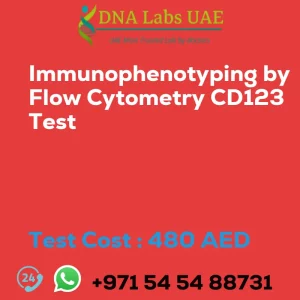IMMUNOPHENOTYPING BY FLOW CYTOMETRY CD5 Test
Components: Price 480.0 AED
Sample Condition: 3 mL (2 mL min.) whole blood in 1 Lavender Top (EDTA) tube AND 3 mL (2 mL min.) whole blood in 1 Green Top (Sodium Heparin) tube OR 2 mL (1 mL min.) Bone marrow in 1 Green Top (Sodium heparin) tube. Ship immediately at 18-22°C. DO NOT REFRIGERATE OR FREEZE. Specify time, date, and clinical details on the test request form.
Report Delivery: Sample Daily by 9 am; Report Same day
Method: Flow Cytometry
Test type: Cancer
Doctor: Oncologist, Hematologist
Test Department: FLOW CYTOMETRY
Pre Test Information: Give brief clinical history.
Test Details:
The CD5 test is an immunophenotyping test performed by flow cytometry to evaluate the expression of CD5 on lymphocytes. CD5 is a cell surface glycoprotein that is expressed on T cells, a subset of B cells, and a small population of natural killer (NK) cells. Flow cytometry is a technique that uses fluorescently labeled antibodies to identify and quantify different cell populations based on their surface markers.
In the case of CD5 testing, a blood or tissue sample is stained with a fluorescently labeled anti-CD5 antibody. The sample is then passed through a flow cytometer, which detects the fluorescence emitted by the labeled antibody and analyzes the data to determine the percentage of cells expressing CD5.
CD5 expression is particularly important in the diagnosis and classification of lymphoproliferative disorders, such as chronic lymphocytic leukemia (CLL) and mantle cell lymphoma (MCL). In CLL, the majority of the malignant cells express CD5, while in MCL, the malignant cells typically show strong and uniform expression of CD5.
In addition to its role in the diagnosis of lymphoproliferative disorders, CD5 testing can also be used to monitor disease progression and response to treatment. Changes in the percentage of CD5-positive cells over time can provide valuable information about the effectiveness of therapy and the overall prognosis of the patient.
Overall, the CD5 test by flow cytometry is a valuable tool in the immunophenotyping of lymphocytes and plays a crucial role in the diagnosis and management of various lymphoproliferative disorders.
| Test Name | IMMUNOPHENOTYPING BY FLOW CYTOMETRY CD5 Test |
|---|---|
| Components | |
| Price | 480.0 AED |
| Sample Condition | 3 mL (2 mL min.) whole blood in 1 Lavender Top (EDTA) tubeAND 3 mL (2 mL min.) whole blood in 1 Green Top (Sodium Heparin) tube OR 2 mL (1 mL min.) Bone marrow in 1 Green Top (Sodium heparin) tube. Ship immediately at 18\u0192??22?\u00f8C. DO NOT REFRIGERATE OR FREEZE. Specify time, date and clinical details on test request form. |
| Report Delivery | Sample Daily by 9 am; Report Same day |
| Method | Flow Cytometry |
| Test type | Cancer |
| Doctor | Oncologist, Hematologist |
| Test Department: | FLOW CYTOMETRY |
| Pre Test Information | Give brief clinical history. |
| Test Details |
The CD5 test is an immunophenotyping test performed by flow cytometry to evaluate the expression of CD5 on lymphocytes. CD5 is a cell surface glycoprotein that is expressed on T cells, a subset of B cells, and a small population of natural killer (NK) cells. Flow cytometry is a technique that uses fluorescently labeled antibodies to identify and quantify different cell populations based on their surface markers. In the case of CD5 testing, a blood or tissue sample is stained with a fluorescently labeled anti-CD5 antibody. The sample is then passed through a flow cytometer, which detects the fluorescence emitted by the labeled antibody and analyzes the data to determine the percentage of cells expressing CD5. CD5 expression is particularly important in the diagnosis and classification of lymphoproliferative disorders, such as chronic lymphocytic leukemia (CLL) and mantle cell lymphoma (MCL). In CLL, the majority of the malignant cells express CD5, while in MCL, the malignant cells typically show strong and uniform expression of CD5. In addition to its role in the diagnosis of lymphoproliferative disorders, CD5 testing can also be used to monitor disease progression and response to treatment. Changes in the percentage of CD5-positive cells over time can provide valuable information about the effectiveness of therapy and the overall prognosis of the patient. Overall, the CD5 test by flow cytometry is a valuable tool in the immunophenotyping of lymphocytes and plays a crucial role in the diagnosis and management of various lymphoproliferative disorders. |







